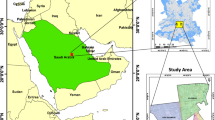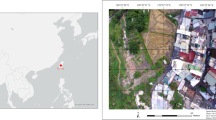Abstract
In many remote sensing image analysis processes, the human operator intervention is an indispensable component. One particular image analysis task where the human operator has a crucial role is in the selection of training data for supervised image classification methods in which essential training data selection is manually carried out by a human operator. This process is facilitated by the operator’s former experiences, perceptual skills, and knowledge about the area of the study. Understanding the expert’s cognitive processes, including reasoning, decision-making, and uses of knowledge to extract training data, can help improve task automation. This study regards training data extraction as a cognitive-behavioral task and attempts to extract semi-automatic training sites from an existing map based on the explanations of the expert performing the task. To support this cognitive approach, a combination of knowledge-based system, integration of remote sensing image analyses, GIS analyses, shape descriptor analyses, and artificial intelligence is used. Finally, to evaluate the reliability and accuracy of the extracted training data sites, they employed three supervised image classification algorithms, artificial neural network (ANN), support vector machine (SVM), and random forest (RF), and results were compared. Overall classification accuracy was obtained were high for three methods: ANN (90.43 %), SVM (86 %), and RF (84.09 %). Also, the kappa coefficients for each of methods are as follows: ANN (0.88), SVM (0.83), and RF (0.80). The results of this classification indicated that the extracted sample data from cognitive approach are reliable and help to semi-automation of supervised image classification process.














Similar content being viewed by others
References
Anderson JR (1981) Cognitive skills and their acquisition. Psychology Press.New York
Benz UC, Hofmann P, Willhauck G, Lingenfelder I, Heynen M (2004) Multi-resolution, object-oriented fuzzy analysis of remote sensing data for GIS-ready information. ISPRS J Photogramm Remote Sens 58:239–258
Bezdek JC, Ehrlich R, Full W (1984) FCM: the fuzzy c-means clustering algorithm. Comput Geosci 10:191–203
Bhatta B (2010) Analysis of urban growth and sprawl from remote sensing data. Springer Science & Business Media,New York City
Blaschke T (2010) Object based image analysis for remote sensing. ISPRS J Photogramm Remote Sens 65:2–16
Bruning RH Schraw GJ, & Ronning, RR (1999). Cognitive psychology and instruction. Prentice-Hall, Inc., One Lake Street, Upper Saddle River, NJ 07458
Campbell JB Wynne RH (2011) Introduction to remote sensing (5th ed.). New York: Guilford Press. p. 393
Card SK, Moran TP, Newell A (1983) The psychology of human-computer interaction,Lawrence Erlbaum Associates; Hillsdale, NJ, USA
Corcoran P., Winstanley AC (2007) “Segmentation evaluation for object based remotely sensed image analysis”
Corcoran P, Winstanley A (2008) “Using texture to tackle the problem of scale in land-cover classification,” in Object-based image analysis, ed: Springer, pp. 113–132
Endsley MR, Hoffman R, Kaber D, Roth E (2007) Cognitive engineering and decision making: an overview and future course. Journal of Cognitive Engineering and Decision Making 1:1–21
Erikson C (1996) Polygonal simplification: an overview. University of North Carolina at Chapel Hill, Chapel Hill
Foody GM (2004) Thematic map comparison. Photogramm Eng Remote Sens 70:627–633
Förstner W, Bonn U (2009) “Computer Vision and Remote Sensing-Lessons Learned,” Fritsch, Dieter (Hg.): Photogrammetric Week, pp. 241–249
Gardin S, van Laere SM, van Coillie FM, Anseel F, Duyck W, de Wulf RR et al (2011) Remote sensing meets psychology: a concept for operator performance assessment. Remote Sensing Letters 2:251–257
Gersh JR, McKneely JA, Remington RW (2005) Cognitive engineering: understanding human interaction with complex systems. Johns Hopkins APL Technical Digest 26:377–382
Gervasi O, Murgante B, Laganà A, Taniar D, Mun Y (2008) Computational science and its applications—ICCSA 2008: International Conference, Perugia, Italy, June 30–July 3, 2008, Proceedings: Springer
GmbH TG (2013) Trimble eCognition® Developer, T. (2014). 9.0 User Guide. Trimble Germany GmbH: Munich, Germany.
Hagan MT, Demuth HB, Beale MH, & De Jesús O (1996) Neural network design, vol. 20. Boston: PWS Publishing Company
International Fuzzy Systems Association. World Congress & International Fuzzy Systems Association (2005) Fuzzy Logic, Soft Computing and Computational Intelligence: Eleventh International Fuzzy Systems Association World Congress, July 28-31, 2005, vol. 1, Beijing. 清华大学出版社有限公司
Kandel A (1991) Fuzzy expert systems. CRC press,Boca Raton, Florida,USA
Kendal SL, & Creen M (2007) An introduction to knowledge engineering. Springer, London, p 1–25
Mamdani EH (1977) Application of fuzzy logic to approximate reasoning using linguistic synthesis. IEEE Transactions on Computers 100:1182–1191
Mas J, Flores J (2008) The application of artificial neural networks to the analysis of remotely sensed data. Int J Remote Sens 29:617–663
Mogharreban N, Dilalla L (2006) “Comparison of defuzzification techniques for analysis of non-interval data,” in Fuzzy Information Processing Society, 2006. NAFIPS 2006. Annual meeting of the North American, pp. 257–260
Ojaghi S, Ebadi H, Ahmadi FF (2015) Using artificial neural network for classification of high resolution remotely sensed images and assessment of its performance compared with statistical methods. American Journal Engineering, Technology and Society 2(1):1–8
Seung S (2002) Multilayer perceptrons and backpropagation learning. 9.641 Lecture 4, p 1–6
Sivanandam M (2009) Introduction to artificial neural networks, Vikas Publishing House Private Limited,Uttar Pradesh, India
Sivanandam SN, & Deepa SN (2006) Introduction to neural networks using Matlab 6.0, McGraw-Hill Education, New York
Van Leekwijck W, Kerre EE (1999) Defuzzification: criteria and classification. Fuzzy Sets Syst 108:159–178
Wang F (1989) “A fuzzy expert system for remote sensing image analysis,” in Geoscience and Remote Sensing Symposium, 1989. IGARSS’89. 12th Canadian Symposium on Remote Sensing., 1989 International, pp. 848–851
Wang F (1990) Fuzzy supervised classification of remote sensing images. IEEE Trans Geosci Remote Sens 28:194–201
Wang Y, Chen Y (2014) A comparison of Mamdani and Sugeno fuzzy inference systems for traffic flow prediction. Journal of Computers 9:12–21
Yu Z, Au OC, Zou R, Yu W, Tian J (2010) An adaptive unsupervised approach toward pixel clustering and color image segmentation. Pattern Recogn 43:1889–1906
Zadeh LA (1997) Toward a theory of fuzzy information granulation and its centrality in human reasoning and fuzzy logic. Fuzzy Sets Syst 90:111–127
Zarandi MF, Zolnoori M, Moin M, Heidarnejad H (2010) A fuzzy rule-based expert system for diagnosing asthma. Transaction E: Industrial Engineering 17:129–142
Zhang D, Lu G (2004) Review of shape representation and description techniques. Pattern Recogn 37:1–19
Author information
Authors and Affiliations
Corresponding author
Rights and permissions
About this article
Cite this article
Ojaghi, S., Ahmadi, F.F. & Ebadi, H. A new method for semi-automatic classification of remotely sensed images developed based on the cognitive approaches for producing spatial data required in geomatics applications. Arab J Geosci 9, 724 (2016). https://doi.org/10.1007/s12517-016-2730-1
Received:
Accepted:
Published:
DOI: https://doi.org/10.1007/s12517-016-2730-1




